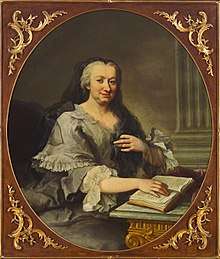Chief Court Mistress
Court Mistress (Danish: hofmesterinde; Dutch: hofmeesteres ('Court mistress'); German: Hofmeisterin; Norwegian: hoffmesterinne; Swedish: hovmästarinna) or Chief Court Mistress (Danish: Overhofmesterinde; Dutch: Grootmeesteres ('Grand Mistress') German: Obersthofmeisterin; Norwegian: overhoffmesterinne; Swedish: överhovmästarinna; Russia: Ober-Hofmeisterin) is or was the title of the senior lady-in-waiting in the courts of Austria, Denmark, Norway, the Netherlands, Sweden, Imperial Russia, and the German princely and royal courts.
Austria
In 1619, a set organisation was finally established for the Austrian Imperial court which came to be the characteristic organisation of the Austrian-Habsburg court roughly kept from this point onward.[1] The first rank of the female courtiers was the Obersthofmeisterin, who was second in rank after the empress herself, and responsible for all the female courtiers.[1] Whenever absent, she was replaced by the Fräuleinhofmeisterin, normally in charge of the unmarried female courtiers, their conduct and service.[1]
Chief Court Mistress to Anna of Tyrol, 1608–1618
- 1611–1618: Freiin Katharina v. Kollowrath-L.
Chief Court Mistress to Eleonora Gonzaga, 1622–1658
- 1621–1624: Gräfin Maria Anna v. Portia
- 1624–1637: Gräfin Ursula v. Attems
- 1637–1644: Freiin Margarita v. Herberstein
- 1647–1647: Gräfin Octavia Strozzi
- 1652–1655: Freiin Anna Eleonora v. Metternich
Chief Court Mistress to Maria Anna of Spain, 1631–1646
- 1630–1638: Victoria de Toledo y Colona
- 1643–1646: Marquesa Flores d’Avila
Chief Court Mistress to Maria Leopoldine of Austria, 1648–1649
- 1648–1649: Gräfin Anna Eleonora v. Wolkenstein 1648–1649
Chief Court Mistress to Eleonora Gonzaga, 1651–1686
- 1651–1658: Gräfin Maria Elisabeth v. Wagensperg
Chief Court Mistress to Maria Theresa of Austria, 1740–1780
- 1740–1754: Marie Karoline von Fuchs-Mollard
Chief Court Mistress to Empress Elisabeth of Austria, 1854–1898
- 1854–1862: Sophie Esterházy
- 1862– : Pauline von Königsegg
- Maria Welser, Gräfin von Welsersheimb Freiin zu Gumpenstein
Denmark
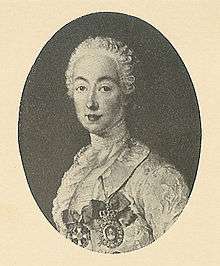
The early modern Danish court was organized according to the German court model, in turn inspired by the Imperial Austrian court model, from the 16th century onward.[2]
The highest rank female courtier to a female royal was the hofmesterinde (Court Mistress) from 1694/98 onward named Overhofmesterinde (Chief Court Mistres), equivalent to the Mistress of the Robes, normally an elder widow, who supervised the rest of the ladies-in-waiting.[3]
When the office was vacant the tasks were taken over by the second in command, the kammarfröken. This was also the case when the office of hofmesterinde to the queen was left vacant in 1808–23 and 1839–45, and was handled by Friederiche Amalie Marie Hedevig von der Manfe and Marie Ernestine Wilhelmine von Walterstorf respectively.[4]
Chief Court Mistress to Christina of Saxony, 1481–1513
- 1490–1496: Sidsel Lunge
- 1503–1516: Anne Meinstrup
Chief Court Mistress to Isabella of Austria, 1515–1523
- 1516–1517: Anne Meinstrup
- 1517–1523: Sigbrit Willoms
Chief Court Mistress to Sophie of Pomerania, 1523–1533
- 1526–1533: Anne Meinstrup
Chief Court Mistress to Dorothea of Saxe-Lauenburg, 1534–1571
Chief Court Mistress to Sophie of Mecklenburg-Güstrow 1572–1631
- 1572–1584: Inger Oxe
- 1584–1592: Beate Clausdatter Bille
Chief Court Mistress to Anne Catherine of Brandenburg 1597–1612
- 1597–1612: Beate Huitfeldt
Chief Court Mistress to Sophie Amalie of Brunswick-Lüneburg 1648–1685
- Lucie von Løschebrand
- 1657–1685: Maria Elisabeth von Haxthausen
Chief Court Mistress to Charlotte Amalie of Hesse-Kassel 1670–1714
- 1677–1692: Juliane Elisabeth von Uffeln
- 1695–1705: Dorothea Justina Haxthausen[7]
- 1705–1707: Sophie Dorothea von Schack von Marschalck
- Louise Charlotte von Schlaberndorf
Chief Court Mistress to Louise of Mecklenburg-Güstrow 1699–1721
- 1699–1716: Abel Cathrine Buchwald
Chief Court Mistress to Anne Sophie Reventlow 1721–1743
- Fru von Grabow[8]
Chief Court Mistress to Sophie Magdalene of Brandenburg-Kulmbach 1721–1770
- Beate Henriette af Reuss-Lobenstein
Chief Court Mistress to Louise of Great Britain 1746–1751
- 1746–1751: Christiane Henriette Louise Juel (first term)
Chief Court Mistress to Juliana Maria of Brunswick-Wolfenbüttel 1752–1796
- 1752–1754: Christiane Henriette Louise Juel (second term)
- 1757–1767: Karen Huitfeldt
- 1772–1784: Margrethe von der Lühe
- 1784–1793: Sophie Louise Holck-Winterfeldt
Chief Court Mistress to Caroline Matilda of Great Britain 1766–1775
- 1766–1768: Louise von Plessen
- 1768–1768: Anne Sofie von Berckentin
- 1768–1770: Margrethe von der Lühe
- 1770–1772: Charlotte Elisabeth Henriette Holstein
- 1772–1775: Cathrine Charlotte von der Horst
Chief Court Mistress to Marie of Hesse-Kassel 1808–1852
Chief Court Mistress to Caroline Amalie of Augustenburg 1839–1881
- 1839–1845: Vacant[11]
- 1845–1859: Ingeborg Christiane Rosenørn
Chief Court Mistress to Louise of Hesse-Kassel 1863–1898
- 1864–1876: Ida Marie Bille
- 1876–1888: Julia Adelaide Harriet Raben-Levetzau
- 1888–1898: Louise Bille-Brahe (first term)
Chief Court Mistress to Louise of Sweden 1906–1926
- 1906–1910: Louise Bille-Brahe (second term)
Chief Court Mistress to Alexandrine of Mecklenburg-Schwerin 1912–1952
- 1912–1935: Louise Grevenkop-Castenskiold
- 1935–1952: Inger Wedell
Germany
The Austrian court model was the role model for the princely courts in Germany,[1] and the post of Obersthofmeisterin, or only hofmeisterin, existed in the princely (and later royal) German courts as well.
The German court model in turn became the role model of the early modern Scandinavian courts of Denmark and Sweden.[2]
- Chief court mistress to the queens of Prussia and empresses of Germany
Chief Court Mistress to Sophia Louise of Mecklenburg-Schwerin 1708–1713
- Countess von Wittgenstein Valendar[12]
Chief Court Mistress to Sophia Dorothea of Hanover 1713–1757
- Sophie von Kameke
- Susanna Magdalena Finck von Finckenstein[13]
Chief Court Mistress to Elisabeth Christine of Brunswick-Wolfenbüttel-Bevern 1740–1797
- 1740–1742: Christiane von Katsch (the same position with the crown princess since 1733)
- 1742–1766: Sophie Caroline von Camas
- 1766–1797: Charlotte Albertine von Kannenberg[14]
Chief Court Mistress to Frederika Louisa of Hesse-Darmstadt 1786–1805
Chief Court Mistress to Louise of Mecklenburg-Strelitz 1797–1810
- 1797–1810: Sophie Marie von Voß (the same position with the crown princess since 1793)[15]
Chief Court Mistress to Elisabeth Ludovika of Bavaria 1840–1873
- Wilhelmine van Reede-Ginkel
Chief Court Mistress to Augusta of Saxe-Weimar-Eisenach 1861–1891
Chief Court Mistress to Augusta Victoria of Schleswig-Holstein 1888–1918
- Therese von Brockdorff
The Netherlands
In the 16th-century, the principal lady-in-waiting in the courts of the Habsburg governors of the Netherlands, Margaret of Austria and Mary of Hungary (governor of the Netherlands), was named hofmesterees ('Court mistress') or dame d'honneur.[16]
The principal female office holder in the royal court of the Kingdom of the Netherlands in the 19th-century was named Grootmeesteres ('Grand Mistress').[17][18]
Norway
During the union of Sweden-Norway in 1814–1905, Sweden and Norway shared the same royal family. At that time, there were two Chief Court Mistress for the same queen: one as Queen of Sweden at the Swedish royal court when she lived in Sweden, and a separate Chief Court Mistress as Queen of Norway at the Norwegian royal court, who served in her post during the visits of the Swedish-Norwegian royal family to Norway.
Presently, the overhoffmesterinne in Norway acts as a vice hostess at the Norwegian royal court when the queen and the other female members of the royal family are absent.
Chief Court Mistress to Hedvig Elisabeth Charlotte of Holstein-Gottorp, 1814–1818
- 1817–1818: Karen Wedel-Jarlsberg
Chief Court Mistress to Désirée Clary, 1823–1861
- 1825–1844: Karen Wedel-Jarlsberg
Chief Court Mistress to Josephine of Leuchtenberg, 1844–1876
- 1844–1845: Karen Wedel-Jarlsberg
- Fanny Løvenskiold
Chief Court Mistress to Louise of the Netherlands, 1859–1871
- 1859–1871: Juliane Cathrine Wilhelmine Wedel Jarlsberg
Chief Court Mistress to Sophia of Nassau, 1872–1905
- 1873–1887: Alette Due
- 1887–1905: Elise Løvenskiold
Chief Court Mistress to Maud of Wales, 1905–1938
- 1906–1925: Marie Magdalena Rustad
- 1925–1927: Emma Stang
- 1927–1938: Borghild Anker
Russia
In 1722, the Russian Imperial court was reorganized in accordance with the reforms of Peter the Great to Westernize Russia, and the old court offices of the Tsarina was replaced with court offices inspired by the German model. Accordingly, the new principal lady in waiting of the Russian empress was named Ober-Hofmeisterin.
Chief Court Mistress to Catherine I of Russia 1713–1725
- Matryona Balk
- Agrippina Petrovna Volkonskaia
- Varvara Michajlovna Arsen'eva
Chief Court Mistress to Elizabeth of Russia 1741–1762
Chief Court Mistress to Catherine II of Russia 1762–1796
Chief Court Mistress to Maria Alexandrovna (Marie of Hesse and by Rhine) 1855–1880
- 1855–1863: Yekaterina Saltykov (in position since 1840)
Chief Court Mistress to Maria Feodorovna (Dagmar of Denmark) 1881–1917
- 1881–1881: Princess Kurakin (in position since 1866)
- 1881–1888: Princess Hélene Kotchoubey
- 1888–: Countess Anna Stroganoff
Chief Court Mistress to Alexandra Feodorovna (Alix of Hesse) 1894–1917
- 1894–1910: Maria Golitzyna
- 1910–1917: Elizaveta Narishkina
Sweden
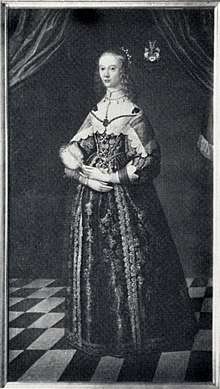
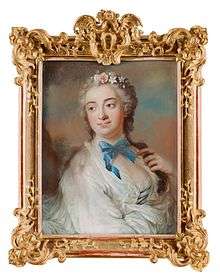
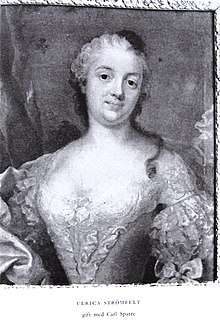
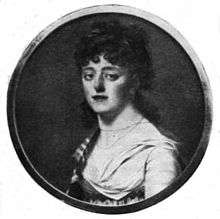
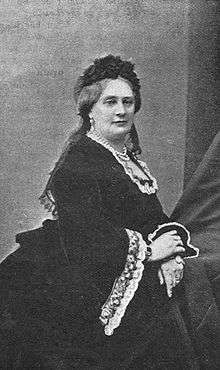
In Sweden, the Chief Court Mistress is the second highest-ranking official of the royal household, preceded only by the Marshal of the Realm. She ranks immediately below the members of the royal family, the speaker of the Parliament and the prime minister, and has precedence over former speakers of the Parliament and former prime ministers. The incumbent is Kirstine von Blixen-Finecke, who has served from 2016.
The title and position have changed over time. Before the reign of Queen Christina (1632–1654), the title was generally referred to as hovmästarinna (Court Mistress), but during and after the reign of Christina, it became the custom to have two such Court mistresses subordinate to one överhovmästarinna (Chief Court Mistress).[19] Only the Queen and the Queen Dowager had a Chief Court Mistress called överhovmästarinna (the Chief Court Mistress) while the equivalent at the courts of other female members of the royal house was called hovmästarinna (Court Mistress).
The position was the highest a female courtier could have in the Swedish royal court, and the överhovmästarinna was ranked an Excellency, something unusual for a woman in the 17th century, which placed her immediately after the female members of the royal house in rank. Her role was to uphold etiquette at court, and receive and carry out the instructions of the Queen in the management of the court. She managed the employment of new members to the court of the Queen, and every meeting and letter to the Queen passed through her.[19] She also managed the ceremony of the court presentation, in which nobles were presented to the royal family and thus allowed to show themselves officially at court.[20] She could also represent the Queen on some occasions at court ceremonies and parties as hostess.
Chief Court Mistress to Catherine Stenbock 1552–1621
- 1552–1568: Anna Hogenskild
Chief Court Mistress to Karin Månsdotter 1567–1568
- 1567–1569: Elin Andersdotter
Chief Court Mistress to Catherine Jagellon 1568–1583
- 1568–1583: Karin Gyllenstierna
Chief Court Mistress to Gunilla Bielke 1585–1597
- 1587–1592: Kerstin Oxenstierna
Chief Court Mistress to Christina of Holstein-Gottorp 1604–1625
- 1604–1608: Carin Ulfsdotter Snakeborg
- 1608–1612: Gunilla Jönsdotter Struss
- 1612–1619: Carin Kyle
Chief Court Mistress to Maria Eleonora of Brandenburg 1620–1655
- 1620–1623: Hebbla Eriksdotter Stålarm
- Catharina von Schnideck
- Regina Catharina von Windisch-Grätz
- 1628–1633: Brita Gylta
- 1633–1634: Ebba Leijonhufvud
- 1634–1639: Elisabeth Gyllenstierna
- 1639–1640: Christina Posse
- 1640–1649: Vacant
- 1649–1655: Görvel Posse
Chief Court Mistress to Christina 1632–1654
During the reign of Christina, the office was often shared by several people.
- 1633–1634: Ebba Leijonhufvud
- 1634–1639: Elisabeth Gyllenstierna
- 1639–1642: Ebba Ryning (jointly with Beata Oxenstierna)
- 1639–1647: Beata Oxenstierna (jointly with Ebba Ryning)
- 1644–1648: Margareta Brahe (jointly with Kerstin Bååt)
- 1645–1650: Kerstin Bååt (jointly with Margareta Brahe)
- 1650: Barbro Fleming (jointly with Maria Sofia De la Gardie)
- 1651–1654: Maria Sofia De la Gardie (jointly with Barbro Fleming)
Chief Court Mistress to Hedvig Eleonora of Holstein-Gottorp, 1654–1715
- 1655–1660: Elisabet Carlsdotter Gyllenhielm
- 1660–1664: Görwel Bååt
- 1664–1671: Görvel Posse
- 1671–1686: Occa Maria Johanna von Riperda
- 1686–1715: Märta Berendes (equivalent position at the court of the princesses in 1687–1717)
Chief Court Mistress to Ulrika Eleonora of Denmark, 1680–1693
- 1680–1693: Maria Elisabeth Stenbock
Chief Court Mistress to Ulrika Eleonora 1718–1741
- 1717–1736: Katarina Ebba Horn af Åminne
- 1736–1741: Hedvig Elisabet Strömfelt (equivalent position to the Crown princess in 1744–1751)
Chief Court Mistress to Louisa Ulrika of Prussia, 1751–1782
- 1751–1751: Hedvig Elisabet Strömfelt
- 1751–1754: Ulla Tessin
- 1754–1761: Ulrica Catharina Stromberg
- 1761–1765: Ulrika Juliana Gyllenstierna
- 1765–1771: Brita Stina Sparre
- 1771–1782: Fredrika Eleonora von Düben
Chief Court Mistress to Sophia Magdalena of Denmark, 1771–1813
- 1771–1777: Anna Maria Hjärne
- 1777–1780: Ulrika Strömfelt
- 1780–1795: Charlotta Sparre
- 1795–1813: Hedvig Eva De la Gardie
Chief Court Mistress to Frederica of Baden, 1797–1809
- 1795–1805: Hedvig Catharina Piper
- 1805–1810: Lovisa Sophia von Fersen
Chief Court Mistress to Hedvig Elisabeth Charlotte of Holstein-Gottorp, 1809–1818
- 1809–1810: Lovisa Sophia von Fersen
- 1811–1818: Christina Charlotta Stjerneld
- 1818–1818: Caroline Lewenhaupt
- 1818–1818: Charlotta Aurora De Geer
Chief Court Mistresss to Désirée Clary, 1823–1861
- 1823–1829: Marcelle Tascher de la Pagerie
- 1829–1844: Vilhelmina Gyldenstolpe
Chief Court Mistress to Josephine of Leuchtenberg, 1844–1876
- 1844–1866: Charlotta Skjöldebrand
Chief Court Mistress to Louise of the Netherlands, 1859–1872
- 1859–1860: Stefanie Hamilton
- 1860–1869: Wilhelmina Bonde
- 1871–1872: Anne-Malène Wachtmeister
Chief Court Mistress to Sophia of Nassau, 1872–1907
- 1872–1879: Elisabet Augusta Piper
- 1880–1890: Malvina De la Gardie
- 1890–1907: Ebba Åkerhielm
Chief Court Mistress to Victoria of Baden, 1907–1931
- 1907–1908: Vacant
- 1908–1931: Augusta Lewenhaupt
See also
- Mistress of the Robes, British equivalent
- Camarera mayor de Palacio, Spanish equivalent
- Première dame d'honneur, French equivalent
- Surintendante de la Maison de la Reine, French equivalent
References
- Nadine Akkerman & Birgit Houben, eds. The Politics of Female Households: Ladies-in-Waiting Across Early Modern Europe (2013).
- Fabian Persson (1999). Servants of Fortune. The Swedish Court between 1598 and 1721. Lund: Wallin & Dalholm. ISBN 91-628-3340-5.
- Klaus Kjølsen: Det Kongelige Danske Hof 1660–2000: en forvaltningshistorisk oversigt, 2010
- Kongelig dansk hof- og statskalender
- Emil Madsen, Forskellige Forhold ved den danske Hofstat i det 16. Aarhundrede, særlig dets anden Halvdel. , Historisk Tidsskrift, Bind 7. række, 3 (1900 - 1902)
- Emil Madsen, Forskellige Forhold ved den danske Hofstat i det 16. Aarhundrede, særlig dets anden Halvdel, Historisk Tidsskrift, Bind 7. række, 3 (1900 - 1902)
- https://archive.org/stream/danskedronnigerf00jorg/danskedronnigerf00jorg_djvu.txt
- https://archive.org/stream/dronningannasoph00bern/dronningannasoph00bern_djvu.txt
- Kongelig dansk hof- og statskalender
- Kongelig dansk hof- og statskalender
- Kongelig dansk hof- og statskalender
- Atkinson, Emma Willsher: Memoirs of the queens of Prussia, London : W. Kent
- https://www.deutsche-biographie.de/sfz16077.html
- http://daten.digitale-sammlungen.de/0001/bsb00016321/images/index.html?fip=193.174.98.30&id=00016321&seite=168
- https://www.deutsche-biographie.de/sfz84111.html#adbcontent
- Jacqueline Kerkhoff: Maria van Hongarije en haar hof 1505–1558: tot plichtsbetrachting uitverkoren
- Dianne Hamer: Sophie: biografie van Sophie van Würtemberg (1818–1877) op basis van brieven en dagboken, 2011
- S Gravenhaagsche” Stads-Almanak: voor 1857
- Fabian Persson (1999). Servants of Fortune. The Swedish court between 1598 and 1721. Lund: Wallin & Dalholm. ISBN 91-628-3340-5
- Tydén-Jordan Astrid, red (1987). Kungligt klädd, kungligt mode. Stockholm: Bergh. Libris 7401256. ISBN 91-502-0849-7
